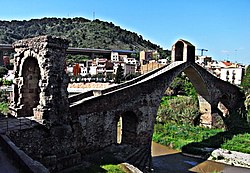
The Llobregat is the second longest river in Catalonia, Spain, after the Ter. It flows into the Mediterranean south of the city of Barcelona. Its name could have originated in an ancient Latin word meaning 'dark', 'muddy' or 'slippery', or simply from its ancient name Rubricatus, literally 'red'.

An arch bridge is a bridge with abutments at each end shaped as a curved arch. Arch bridges work by transferring the weight of the bridge and its loads partially into a horizontal thrust restrained by the abutments at either side, and partially into a vertical load on the arch supports. A viaduct may be made from a series of arches, although other more economical structures are typically used today.

Devil's Bridge is a term applied to dozens of ancient bridges, found primarily in Europe. Most of these bridges are stone or masonry arch bridges and represent a significant technological achievement in ancient architecture. Due to their unusual design, they were an object of fascination and stories in antiquity and medieval Europe.

The Pont Saint-Martin is a Roman bridge in the Aosta Valley in Italy dating to the 1st century BC.

The Alconétar Bridge, also known as Puente de Mantible, was a Roman segmental arch bridge in the Extremadura region, Spain. The ancient structure, which featured flattened arches with a span-to-rise ratio of 4–5:1, is one of the earliest of its kind. Due to its design, it is assumed that the bridge was erected in the early 2nd century AD by the emperors Trajan or Hadrian, possibly under the guidance of Apollodorus of Damascus, the most famous architect of the time.

The Trezzo sull'Adda Bridge or Trezzo Bridge was a medieval bridge at Trezzo sull'Adda in Lombardy, Italy, spanning the Adda river. Completed in 1377, the single-arch bridge held the record for the largest span for over four hundred years, until the beginnings of the Industrial Age, while it was not until the early 20th century that masonry bridges with larger openings were constructed.
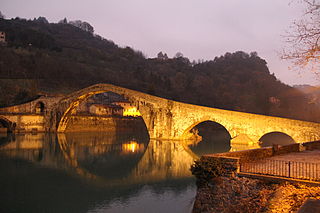
Ponte della Maddalena is a bridge crossing the Serchio river near the town of Borgo a Mozzano in the Italian province of Lucca. It's one of numerous medieval bridges known as Ponte del Diavolo, the "Bridge of the Devil", it was a vital river crossing on the Via Francigena, an early medieval road to Rome for those coming from France that was an important medieval pilgrimage route.

The Pont du Diable or Pont Vieux is a medieval stone arch bridge at Céret, France, built between 1321 and 1341. It spans the Tech River with a single arch of 45.45 metres (149.1 ft). At its apex, the arch is 22.3 metres (73 ft) high.

The Pont Grand is a stone bridge connecting Tournon-sur-Rhône to Saint-Jean-de-Muzols, in Ardèche, France, built between 1379 and 1583. The bridge features a single, semi-circular arch over the river Doux with a span of 49.20 m. The height of the piers is 17.73 m.

The Puente de San Martín is a medieval bridge across the river Tagus in Toledo, Spain.
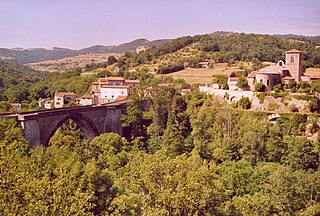
Pont de Vieille-Brioude is located in France, crossing the river Allier. It is a masonry arch bridge with a span of 45 metres (148 ft) that was built in 1832.

The Nyons Bridge is a medieval bridge over the river Eygues in Nyons in southern France.
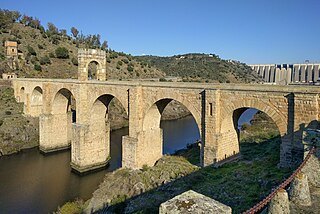
The Alcántara Bridge is a Roman bridge at Alcántara, in Extremadura, Spain. Alcántara is from the Arabic word al-Qantarah (القنطرة) meaning "the arch". The stone arch bridge was built over the Tagus River between 104 and 106 AD by an order of the Roman emperor Trajan in 98.
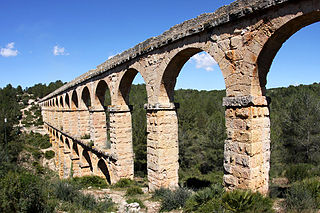
The Ferreres Aqueduct, also known as the Pont del Diable, is an ancient bridge, part of one of the Roman aqueducts that supplied water to the ancient city of Tarraco, today Tarragona in Catalonia, Spain. The bridge is located 4 km north of the city and is part of the Archaeological Ensemble of Tarraco.

The Pont sur la Laye or Pont roman de Mane is an old stone arch bridge across the stream Laye in the French Provence close to the town Mane.

The Roman Bridge at Saint-Thibéry was a Roman bridge on the Via Domitia in southern France. The partly surviving structure crossed the river Hérault in Saint-Thibéry, 17 km (11 mi) east of Béziers.
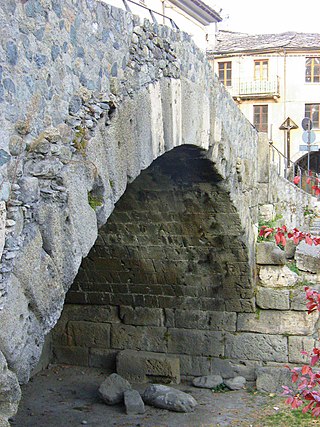
The Pont de Pierre, meaning "Stone Bridge", is a Roman bridge in the Italian city of Aosta in the Aosta Valley. The bridge crossed the Buthier about 600 m (2,000 ft) from the eastern exit of the Roman colony Augusta Praetoria; in later times the torrente changed its course, leaving the ancient bridge today without water.
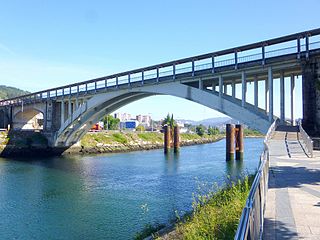
The Barca Bridge is a bridge over the Lérez River, at its mouth in the Pontevedra Ria, which connects the city of Pontevedra with the municipality of Poio in Spain.
